 Image search results - "old" Image search results - "old" |

Nose Myokenzan Betsuin at a street corner. In Feb., priests at this small temple splash cold water on themselves for 30 min. Near Honjo-Azumabashi Station on the Toei Asakusa Line or JR Kinshicho Station on the Sobu Line.
|
|

Shrine hall
|
|

Barrels of cold water in front of shrine
|
|

Barrels of cold water
|
|

The congregation gather on the steps and beat fan-shaped drums.
|
|

Priests appear
|
|
|
|
|
|

Chanting prayers
|
|
|
|
|
|

Priests splash cold water over themselves at the Nose Myokenzan Betsuin in Sumida-ku, Tokyo
|
|
|
|
|
|

They march up to the end of the line of worshippers lined up to pray at the shrine. Then they turn around and head back.
|
|
|
|
|
|

Filled with a water hose
|
|
|
|

Asakusa Butsudan-dori is a road between Tawaramachi Station (Ginza Line) and Ueno Station lined with many shops selling butsudan (household Buddhist altar) and household Shinto altars (kamidana). It is perpendicular to the Kappabashi kitchenware road.
|
|

The butsudan road is about 1 km long lined with about 40 butsudan shops. Buddhist altar craftsmen and shops have been here since the Edo Period, serving temples in Asakusa and Ueno.
|
|

Most of the butsudan household Buddhist altars you see are compact, modern ones that cost much less than the traditional and ornate butsudan.
|
|

Many of the modern butsudan are made in China and Vietnam, squeezing out the traditional Japanese butsudan craftsmen.
|
|

Urban areas like Tokyo typically have small homes so the market is for compact, modern butsudan.
|
|
|
|
|

Certification seal indicating that it is made in Tokyo.
|
|
|

Rosary, incense, and other Buddhist implements are also sold.
|
|

Notice that the butsudan shops are on the south side of the road so they are shaded from the sun that can damage the butsudan.
|
|

Memorial tablets for the deceased.
|
|
|

Seated Buddha statues for the altar.
|
|

They also sell bigger items used in temples. Such items are typically bought by a temple member who donates it to the temple in memory of someone.
|
|
|
|

Entrance to Kappabashi kitchenware road. The Butsudan-dori road is perpendicular to Kappabashi.
|
|
|

Shinto altar shop.
|
|

Household Shinto altars are called kamidana. One of the few Shinto altar shops on this road dominated by Buddhist altar shops.
|
|

Household Shinto altar.
|
|

A larger Shinto altar or small shrine.
|
|

This shop sells Shinto portable shrines you see at festivals.
|
|

Mikoshi portable shrines for sale.
|
|
|
|

Incense
|
|
|
|
|

Buddha images for smaller butsudan altars.
|
|

Hikone Byobu folding screen is a National Treasure and exhibited for a few weeks in April-May. Read more here
|
|
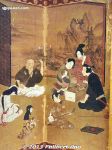
Hikone Byobu (彦根屏風) is a 17th-century National Treasure (国宝) folding screen. Painted on gold leaf, it shows a fashion-leading pleasure quarters scene in Kyoto (京都の遊里).
|
|
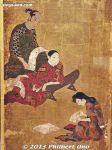
A variety of people, fashion, hairstyles, and objects from that era are depicted. See people playing the samisen, playing sugoroku Japanese backgammon, or writing a love letter.
|
|
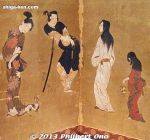
Notice the tobacco pipe and Western dog too. Artist is unknown, but likely belonged to the Kano school of Japanese painting (狩野派).
|
|
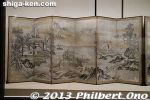
Other folding screens on display.
|
|

This is the old Ishigaki Airport before it closed in March 2013 and was replaced by the new and current airport slightly north of this old airport.
|
|

Approaching the old Ishigaki Airport terminal.
|
|

Old Ishigaki Airport terminal, Arrivals. No jet bridges. Jets (Boeing 737) started flying here only from 1979.
|
|

Old Ishigaki Airport terminal for JTA, Arrivals. No jet bridges.
|
|

Old Ishigaki Airport terminal for JTA. Small building. The old airport first opened in 1943 for military use. It became a civilian airport in 1956.This passenger terminal building was built in 1961 and used mainly by JTA (Japan Transocean Air) and RAC (Ryukyu Air Commuter). ANA had its own adjacent terminal.
|
|

At the old Ishigaki Airport, inside the JTA passenger waiting area at the boarding gate.
|
|

At the old Ishigaki Airport, JTA boarding gate. One of the check-in staff wears a yukata. Also notice the old digital signage.
|
|
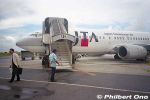
No jet bridge, but it wasn't a problem when it didn't rain.
|
|

I liked walking on the tarmac to the plane at Ishigaki Airport.
|
|

Walking on the tarmac to the JTA plane at Ishigaki Airport.
|
|

JTA plane's see-sa at Ishigaki Airport.
|
|

Inside JTA plane, flight attendants figuring out what to tell us.
|
|

Ground crew at the old Ishigaki Airport waving goodbye to us. I waved back.
|
|

Runway at the old Ishigaki Airport. The slanty white building visible is the ANA hotel on the beach. That's how close the old airport was to town.
|
|
|
|

On Runway 04 at the old Ishigaki Airport. At 1,500 meters, it was too short for jets larger than a Boeing 737. So the new airport was built on a different location.
|
|

Taking off at the old Ishigaki Airport.
|
|

Taking off at the old Ishigaki Airport.
|
|
|
|
|

Baby Baby Sitter. Such scenes were common in those days. Mom and dad were both busy farming, leaving the baby in the hands of older children. Hand-colored.
|
|
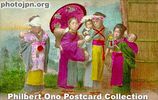
Young baby sitters. The girls look around 8 or 9 years old. The artist went slightly overboard with the hand coloring. Colorful, but too bold.
|
|

Child dancer. Postcard-size photograph. Date is unknown.
|
|

Girl on stage. Postcard-size photograph. Date is unknown.
|
|
|

Twins. They look like twins or sisters. Real-photo postcard postmarked 1918.
|
|

Autographed as Yoko Aozora. She must have been some kind of teenaged entertainer. Probably a dancer. Looks charming enough.
|
|

New Year's photo. The paper ball is for a traditional New Year's game. Postcard-size photograph.
|
|
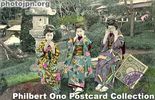
Speak, Hear, and See No Evil. A common pose imitating the monkeys. Postmarked 1914. Hand-colored.
|
|
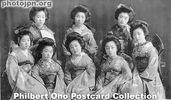
Young girls in kimono.
|
|
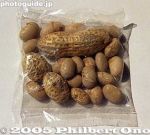
Bag of beans. I caught this from Dejima. They throw little bags of beans instead of individual beans. Bean bags are much easier to catch and to clean up afterward.
|
|

In central Otaru, the Ironai-dori and Sakai-machi-dori streets are lined with numerous historic buildings. Architecture buffs will love this street. This is the Otaru Unga Terminal, formerly Mitsubishi Bank's Otaru Branch.
|
|

Inside the Otaru Unga Terminal, formerly Mitsubishi Bank's Otaru Branch. This area is known as the "Wall Street of the North" due to the many banks and finance-related companies that were here.
|
|

Otaru Post Office
|
|

Wind chimes along a canal.
|
|

Former Hyakujusan Bank, Otaru Branch, now a large glassware shop. 旧百十三銀行小樽支店
|
|

Inside former Hyakujusan Bank, Otaru Branch
|
|

Former Takasaburo Natori Store, now the Taisho Glass Shop. 旧名取高三郎商店、大正硝子館
|
|

Inside Taisho Glass Shop 大正硝子館
|
|

Another glassware shop.
|
|
|
|

Former Motosaburo Kaneko Store, built in 1887. 旧金子元三郎商店
|
|

Konbu shop
|
|

Shop selling konbu or seaweed. The ceiling is covered with konbu.
|
|

Former Dai-Hyakujusan National bank, Otaru Branch, now a gift shop. 旧第百十三国立銀行小樽支店
|
|

Old fire hydrant
|
|
|
|
|

Glassware makers
|
|
|
|
|

Kitaichi Venetian Art Museum opened in 1988. Facade is modeled after the Palace of Grassi.
|
|

Inside Kitaichi Venetian Art Museum with a real gondola once ridden by Prince Charles and Princess Diana.
|
|

Gondola displayed in Kitaichi Venetian Art Museum. The art gallery charges 700 yen admission. Gift shop sells Venetian glass and masks.
|
|

Uroko fish market popular with tourists.
|
|

Uroko fish market
|
|

Hokke, 500 yen each
|
|

Crab
|
|

Trolley bus
|
|

Sakai-machi-dori
|
|

Kitaichi 北一
|
|

Inside Kitaichi
|
|
|
|

Marchen Intersection メルヘン交差点
|
|

Clock in front of the Otaru Orgel-do (Otaru Music Box Hall)
|
|

Plaque of Gastown Vancouver, Canada
|
|

Otaru Orgel-do (Otaru Music Box Hall) is one of the more famous buildings. Built in 1912. 小樽オルゴール堂、旧共成(株)
|
|

Inside Otaru Orgel-do, full of music boxes of all kinds. 小樽オルゴール堂
|
|

Otaru Orgel-do
|
|
|
|
|
|
|
|
|
|
|
|
|
|
|
|
|

Oil-painted card of Mt. Fuji. This is my favorite oil-painted postcard in my collection. The artist painted a few other cards like it. The artist's name was not signed, unfortunately. But the painting style is distinct.I can't define what fine art is, but I know it when I see it.
|
|

Oil-painted card of Mt. Fuji 2. Another postcard oil painting of Mt. Fuji.
|
|

"Japs" on hand-painted Mt. Fuji card. The message on this card reads: "Fujiyama, the mt. (mountain) the Japs worship. Been seeing Yokohama in a jinrichisha (rickshaw). Feb. 14."This person apparently learned a few Japanese words like "jinrikisha" which means "human-powered vehicle" that is the rickshaw. And the term "Japs" has been around well before World War II.
|
|
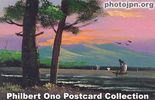
Painting by high school girl? This is my only oil-painted card that has a message and postmark (1910 from Nagasaki). It was addressed to a lady in Alameda, California and says in English that the card was hand painted by a Japanese high school girl.Whether this is true or not, I don't know. But the painting style of this card and the others you see here are the same. (I bought them as a set.)
|
|
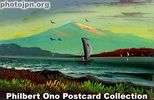
Oil-painted card of ocean and mountain. Apparently by the same artist as the preceding card.
|
|
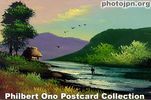
Oil-painted card of river. Apparently by the same artist as the preceding card.
|
|
|
|
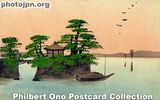
Oil-painted card of Matsushima. Matsushima is a picturesque group of pine tree islands near Sendai, Miyagi Pref. The island pictured is one of the main islands and a major tourist stop.Along with Amanohashidate in Kyoto and Miyajima in Hiroshima, Matsushima is known as one of the three most famous views of Japan (Nihon Sankei).
|
|
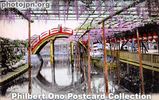
Kameido Tenmangu Shrine, Tokyo. Famous since the Edo Period for wisterias, this shrine has been a popular subject for woodblock artists and early photographers. The wisterias bloom around late April. The shrine is near Kameido Station on the Sobu Line.The shrine is near Kameido Station on the Sobu Line in Tokyo. Hand-colored.
|
|
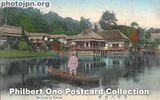
Tea house garden in Hikone, Shiga. This cozy Japanese garden has tea houses. It is directly behind Hikone Castle in Shiga Prefecture. Hikone Castle was the home of Naosuke Ii, the high official who met Commodore Perry.Today, this garden still looks pretty much the same. It was even used for a garden scene in the TV mini-series "Shogun." See photos here.
|
|
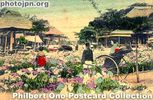
Iris Garden at Horikiri, Tokyo. This card is made of balsa wood. It shows a woman arriving at the garden in a rickshaw. I've seen this photo printed on paper postcards as well. The garden still exists in Tokyo and it's still famous for irises.See photos of the garden today. It's still famous for irises that bloom in June. Hand-colored postcard.
|
|

Inside Ariake Colosseum. The front row seats along the court edge are called "Premium Seats" which cost 20,000 yen each. Includes free drinks and food delivered to your seat.
|
|

Ryukyu Golden Kings practice.
|
|

Tokyo Apache practice.
|
|

National anthem
|
|

The Koto Ward mayor tosses the ball for a tip-off.
|
|

The game started at 6 pm.
|
|
|

Joho Masashi
|
|

Joho Masashi
|
|

Darin Maki
|
|

Dunk
|
|

John "Helicopter" Humphrey
|
|

The game was very enjoyable. But Ariake Colliseum had no heating. It was pretty cold, you need to wear a jacket. But I can imagine the cost of heating this huge arena.
|
|
|
|
|
|

John
|
|

Cohey Aoki
|
|
|
|

Iwasa Jun
|
|
|
|

Nick Davis for free throw.
|
|

Cohey Aoki
|
|
|
|
|
|
|

Make a wave!
|
|
|
|

Helicopter
|
|

Darin Maki is from California.
|
|

Anthony McHenry
|
|

Helicopter flies up
|
|
|

Ryukyu Golden Kings fan section. They came all the way from Okinawa?
|
|

John up again
|
|

Darin
|
|
|

Takushi Naoto of Ryukyu Golden Kings
|
|

Nice dunk
|
|

John flies up again.
|
|
|
|
|
|
|
|

Game ends amid loud cheers by Apache fans.
|
|

Opposing teams shake hands.
|
|

Final score: 100-99, Tokyo Apache win by 1 point.
|
|
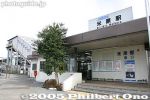
Old Maibara Station on the west side.
|
|

Old Maibara Station's shinkansen turnstile entrance.
|
|
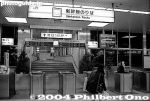
Old Maibara Station's shinkansen turnstile entrance.
|
|

Old Maibara Station's waiting room.
|
|
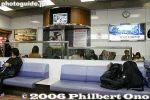
Old Maibara Station's comfortable waiting room was accessible by all. Now, only shinkansen passengers have a nice waiting room. The waiting room is near the shinkansen turnstile. It had a TV, noodle shop, vending machines, and air conditioning.
|
|

Old Maibara Station corridor.
|
|
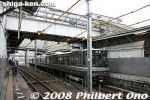
Maibara Station renovation work.
|
|
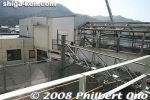
Old corridor of Maibara Station being dismantled in 2008.
|
|
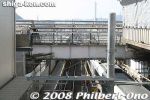
Old corridor of Maibara Station being dismantled.
|
|
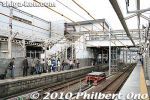
Old corridor of Maibara Station being dismantled.
|
|

Waiting room on the platform. It had peeling paint.
|
|

This air-conditioned waiting room for regular trains was renovated finally by 2011.
|
|
|
|
|
|
|